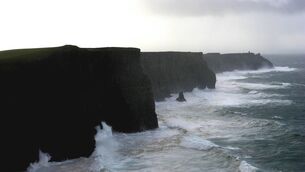Fishermen lose High Court action challenging how fishing authority calculates catches of Dublin Bay prawns

Two fishermen have lost a High Court action challenging the way the fishing authority calculated catches of Dublin Bay prawns in order to conserve the species.
Pat Fitzpatrick, who fishes out of Ros a Mhil in Galway, and Michael J Flannery, a Dingle, Co Kerry-based fisherman, challenged the methodology used by the Sea Fisheries Protection Authority (SFPA) to assess catches which then dictates whether EU quotas had been reached.
It had led the Minister for Agriculture Food and Marine issuing a closure order from November 2017 over a particular section of sea off the west coast, known as functional area 16, to fishing for Nephrops, more commonly known as Dublin Bay prawns.
The fishermen, who said they were paying mortgages on their vessels and employing 12-14 fishermen between them along with more people onshore, said the decision was causing them serious hardship and might even put them out of business. If they were forced to fish for other species there was a danger they might put other fishermen, already fishing for particular species, out of business, they said.
They sued the Minister for Agriculture Food and Marine and the SFPA. The defendants stood over the methodology used to assess catches.
The SFPA said there was a serious problem of Irish fishermen under-reporting in their electronic fishing logs the amount of Dublin Bay prawns actually caught in functional area 16.
It said that the problem was of such grave proportions that in order to comply with EU law to provide accurate information, it had to employ a methodology whereby it calculated the catches based on the actual time spent by a vessel at sea rather than what was in the fishing logs.
As a result, while the overall logged catch up to October last year was 733 tonnes, the figure assessed by the SFPA was 1991 tonnes. The quota was therefore reached and the fishing area was closed.
Dismissing the men's action, Ms Justice Úna Ní Raifeartaigh said one of the fishermens' criticisms was the SFPA methodology was not "scientifically grounded".
It was important to remember however, she said, the electronic logbooks used by the fishermen themselves were not scientific in any way.
"They are only as accurate as the individual fisherman is honest," she said.
The legal obligation placed on the SFPA must be to report figures it believes, on reasonable grounds, to be accurate, she said.
Dr Colm Lordan, of the Galway Marine Institute and who advises on the sustainable exploitation of Irish marine resources, gave evidence that the SFPA methodology was a scientifically respectable one. He also said it was not dissimilar to that used by the Irish Council for Exploitation of the Seas which advises the EU Commission at a more macro level in relation to stock quotas.
While the "time spent at sea" method is not as perfectly accurate than if there were inspectors on every vessel, it seemed to be a reasonable alternative to the electronic log figures in circumstances where those figures were "for good reason, suspected to be unreliable", the judge said.
The fishermens' suggestion that the methodology of the SFPA created an uneven playing field for Irish fishing vessels, appeared to involve the assumption that fishermen from other EU states were engaging in false reporting, she said.
Rather than suggesting a blind eye be turned by the SFPA to misreporting of catches, the remedy lay in lobbying the EU Commission about it, she said.












